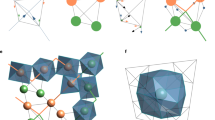Abstract
Optical frequency doubling in powdered NH4Cl near the order-disorder transition temperature of Tc ≈ 242. 4°K has recently been reported[1, 2]. These experiments have been interpreted in terms of the pair correlation function, G(r), for angular reorientation of \(NH_4^ + \)ions, and have been found to lead to results that are in apparent conflict with present critical point theory.
Access this chapter
Tax calculation will be finalised at checkout
Purchases are for personal use only
Preview
Unable to display preview. Download preview PDF.
Similar content being viewed by others
References
(a) I. Freund, Phys. Rev. Letters 19, 1288 (1967);
(b) Critical harmonic scattering has also been considered by J. Lajzerowicz, Solid State Comm. 3, 369 (1965).
I. Freund, Chem. Phys. Letters 1, 551 (1968).
(a) M.E. Fisher and R.J. Burford, Phys. Rev. 156, 583 (1967);
(b) M.E. Fisher, J. Math. Phys. 5, 944 (1964).
I. Freund, J. Chem. Phys. 45, 3882 (1966). Eq. (4) follows fairly directly from the content of this paper.
S.J. Cyvin, J.E. Rouch, and J.C. Decius, J. Chem. Phys. 43, 4083 (1965).
The (machine) calculation proceeded as follows: a 200 line table of σ(ϰ)/σmax vs ϰ was constructed using an available Simpson’s rule numerical integration routine and Eq. (3). 4-point Lagrangian interpolation in this table was used to obtain σ(ϰ) and ϰ(σ), as required. A 10 point coarse grid of σmax was established, ϰ(σ) computed for the first point on this grid, and the corresponding values of A (σmax) and v(σmax) determined using standard least squares procedures by linearizing ϰ = A(T/Tc-1)v. The quantity δ(σmax) =Σ[σcalc-σexp)/σcalc]2 was computed and the process repeated for all values of σmax on the grid. The value of σmax leading to a minimum in δ was chosen as the best estimate of this quantity, a new, finer, grid established about this point, and the whole procedure repeated. Convergence was smooth, and the processing of 310 data points consumed slightly less than 1 minute on a GE 645 computer.
Author information
Authors and Affiliations
Editor information
Editors and Affiliations
Rights and permissions
Copyright information
© 1969 Springer Science+Business Media New York
About this paper
Cite this paper
Freund, I. (1969). Critical Harmonic Scattering in Powdered NH4Cl. In: Wright, G.B. (eds) Light Scattering Spectra of Solids. Springer, Berlin, Heidelberg. https://doi.org/10.1007/978-3-642-87357-7_70
Download citation
DOI: https://doi.org/10.1007/978-3-642-87357-7_70
Publisher Name: Springer, Berlin, Heidelberg
Print ISBN: 978-3-642-87359-1
Online ISBN: 978-3-642-87357-7
eBook Packages: Springer Book Archive




